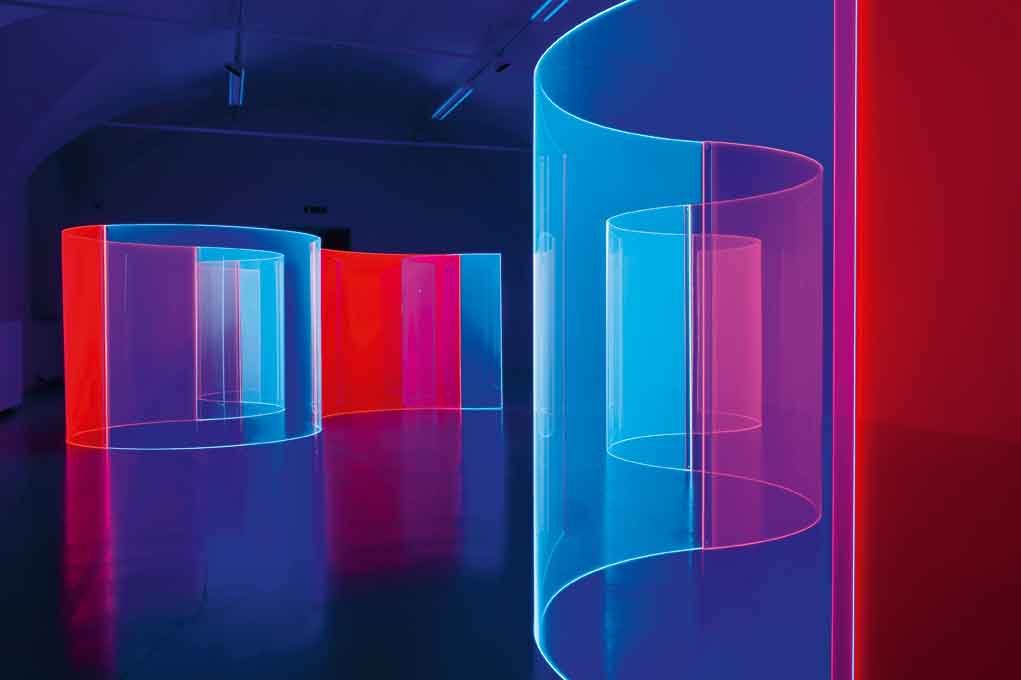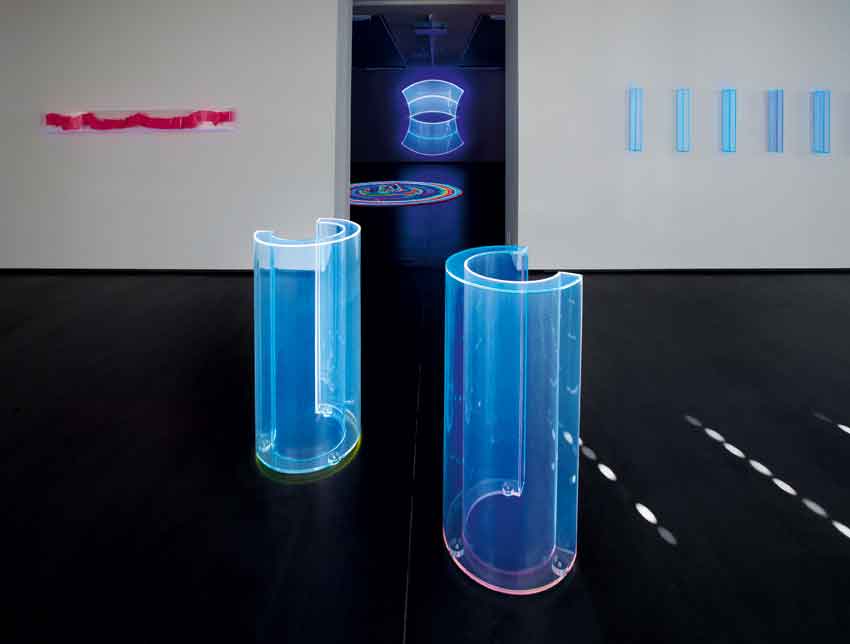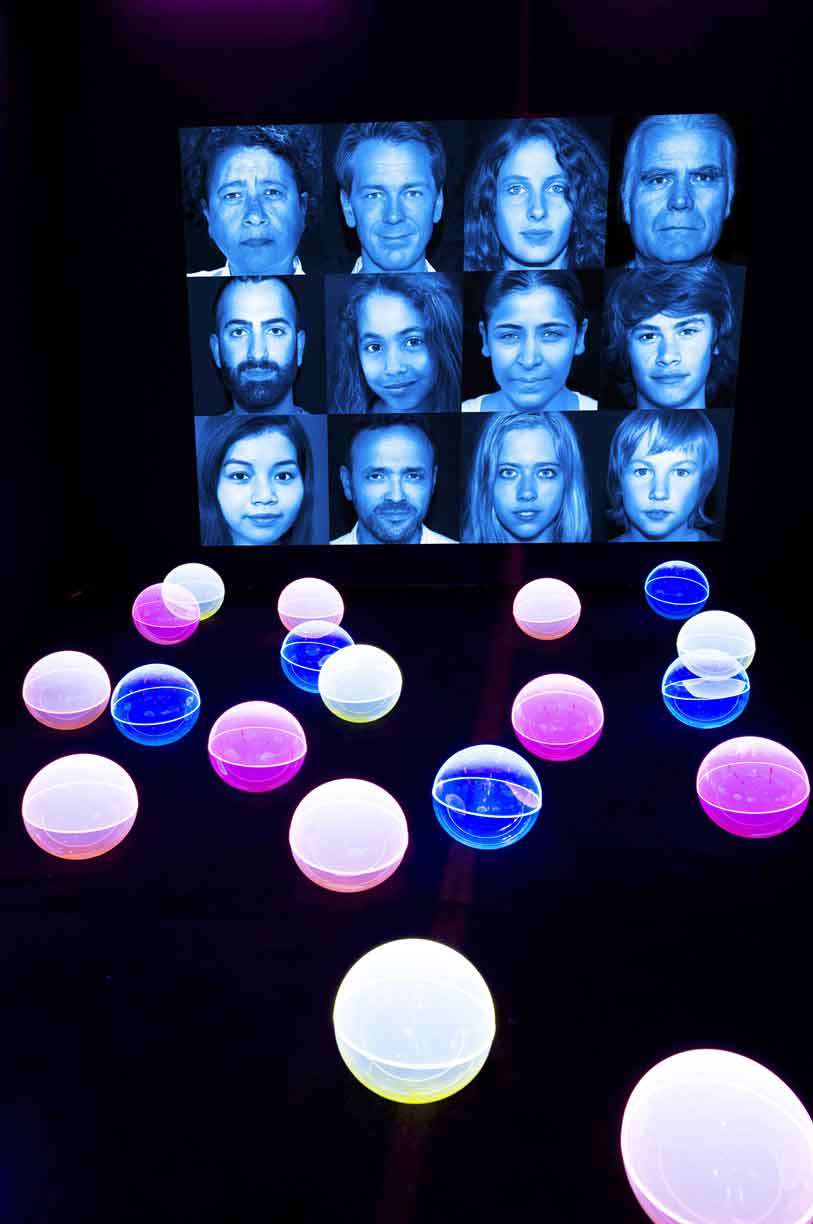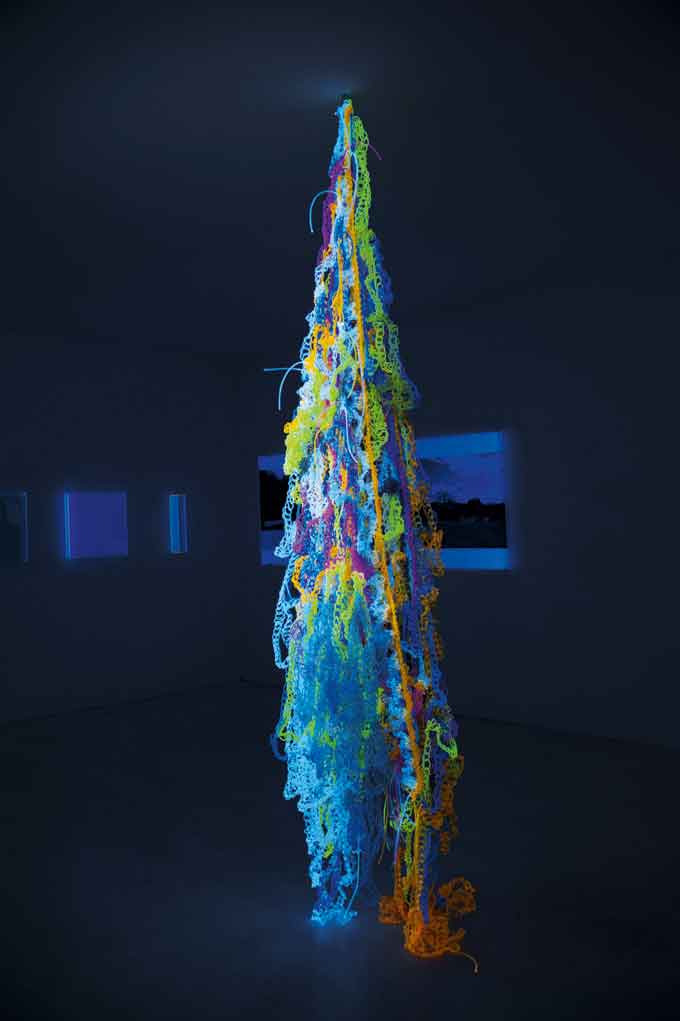« Features
Provoking Emotion with Form and Color. Interview with Regine Schumann
* All images are courtesy of the artist and Galerie Lausberg, Düsseldorf-Toronto-Miami.
Regine Schumann’s installations are much more than concrete art. Conceptualized as emotive spaces, Schumann’s color-filled light rooms provoke intense feelings of something otherworldly. A minimalist style affects everything from her choice of materials to the way she plays with form and color. One of her recent exhibits makes the visitor part of the installation itself; another encourages dialogue between art forms.
By Angela Boskovitch
Angela Boskovitch - You don’t make the actual materials for your work, but rather have them produced. Why is how they’re manufactured so important to your installations?
Regine Schumann - I develop the concept, draw the forms and choose the dimensions and colors of the panels to be assembled. These are special plates not normally available. They’re precision cut with a laser and then fused together. This work has to be extremely precise and done by hand. I don’t have the machines for such work. I’m a painter by training, and painters often use pigments with different materials to color them. That’s the case with these panels as well. Phosphorescent pigments mean that the colors in the plates are luminescent in black light. I’m kind of a pioneer here because I’m working with the firm producing the pigments to have them integrated directly into the manufacture of my panels. This means that the material is imbued with them, illuminating the entire panel rather than just the surface as it would if you painted them on with a brush. As a painter I used to do this work myself, but now I have it done, with the exception of the crochet work which links the plastic lights in a kind of net. That I do myself. I don’t find this to be something negative at all. My artistic approach begins with the room for the installation. That’s the decisive factor.

Regine Schumann, Connect, Back to Back, 2011, Fluorescent Plexiglass, 4.26’ x 6.56’ x 4.7”, 12 elements.
A.B. - And yet you don’t consider yourself to be a concrete artist?
R.S. - A lot of people think that I’m a concrete artist because the acrylic color boxes represent this concrete structure in a way. But if you really know me, then you know that I’m very playful, poetic and above all spontaneous in my work. I’m using the highest quality materials in how they’re assembled in plates, but I’m also playing with how to draw colors and forms into a room. I work in a way driven by feelings, where I sense the atmosphere of a room rather than work with mathematical dimensions. When I get started I’m thinking about the room and how it actually feels to be there. I’ve gone through it a hundred times in my mind. I like to create really intensive rooms with many different colors or to have one color that’s dominant while you go through the room. It’s about an atmosphere of intensive color which is like a shower. People say that I create a really special atmosphere out of our normal day-to-day life. When you’re in my rooms, it’s like you’re in another world. Not in the daylight installations, which are more like paintings, but under the influence of the black light, when the rooms are dark and all my pieces are glowing. Then you have the impression that there’s something special there from another world, separate from just normal art pieces. The installations really touch you.

Strudel, 2001, Plastiligth strings, fluorescent black light, diameter: Ø 13’. Installation at Galerie Baumgarte, Bielefeld. Photo: Ulrich Helweg.
A.B. - In your exhibit “Connect, back to back - Lichträume” at the Samuelis Baumgarte Galerie in Bielefeld, Germany, there’s an installation with four squares on the wall in combination with what resembles a mandala form. What experience is this designed to invoke?
R.S. - There you have both light situations. One room is rather dark with no daylight where these large squares hang on the walls and a large round crochet work piece is on the floor. It’s mind-altering in a way to stand there. I began netting the round piece in the middle until it became larger and larger, finally reaching a diameter of nearly four meters. I intentionally added many chain stitches in the middle so that it’s raised like a small mountain rather than being entirely flat. I wanted there to be plasticity within the round shape itself. Some nine colors are there in all. The large piece on the floor is very refined, almost moving within the room itself, scattering its light to the rather quiet squares on the walls. In the entire room there’s a really striking atmosphere of motion and movement which exists simultaneously with the quiet of the quadratic surfaces. I find squares to be quiet, while a circle is more dynamic with its movement. This is what’s experienced in this room.

Omega I, 2009, Fluorescent Plexiglass, 37.8” x 3.2” x 19”. Installation at Galerie Baumgarte, Bielefeld. Photo: Ulrich Helweg.
A.B. - And what about the boxes that contain forms in a series, which often find their way into your installations?
R.S. - These are works of successive additions that I really like-sequences of six to eight pieces. What I find really striking is the interplay of the colors. My materials not only contain luminescent pigments within them, but can also have black colors. In one hanging piece with a series, I use black. I’ve been using shapes in this way since the “Dreamteam” exhibit in Santa Fe. I was travelling this summer in Texas and Colorado and the idea came to me of combining black and white in a new way to expand my range of colors, and this is the result-a pallet of new, emotive colors. What’s important is the stirring aftereffect this now creates in my works.
A.B. - You also took part in the group installation “streng geometrisch” at the Museum Moderner Kunst Kärnten in Klagenfurt, Austria, where there was a piece that you could actually walk through. What’s your idea behind such a large work?
R.S. - This is really new. In the acrylic boxes there’s a flexible, moveable PVC band. I had the idea of using the flexibility of this material to create an installation which you could actually walk through, and this is it. They’re 1.32-meter-high panels put together with two screws, which is why I call the work “connect.” They create a new feeling because you’re actually able to walk through the work and become part of it. The panels are red and transparent blue, which intensifies in the dark light. My heart is really in large installations like these.

Regine Schumann, Dreamteam, 2006/2011, 60 Fluorescent balls and fine art prints (Alberto Frei). Installation at Art Santa Fe, 2011 in collaboration with Galerie Bender, Munich. Photo: Alberto Frei.
A.B. - And this is minimalist inspired?
R.S. - Absolutely. The idea is to work with minimal forms and colors in a way that the visitor can always experience something new in the rooms, in a world of form and color. That you’re there and yet can keep developing this in your own way is really exciting. This is industrial plastic, and to transform this into a kind of poetry is really inspiring. It’s a contrast in a way to all the man-made challenges constantly surrounding us. I need this as a comparison. There’s clarity in simplicity, and a kind of freedom can be indulged in through this world of form and color. This is what challenges me, especially in an installation such as this.
A.B. - In Madrid, you’re exhibiting concrete art together with your painting and sketches for the first time and in combination with the photography of Alberto Frei in “touch me.” How are you developing this?
R.S. - The plan for the show was developed with the gallery owner Rafael Pérez Hernando and is supported by the Goethe-Institut. The space will feature a comprehensive selection of my fluorescent light works together with Frei’s panoramic shots of Cologne and Texas-colorful landscapes which will also be shown under black light. “touch me” is imagined as a kind of dialogue between the plastilightstrings, large-scale fluorescent “colormirror works,” my previously unpublished drawings and Frei’s large-format photographs. In conceiving the space, I wanted to create a special environment that’s part of this substantive dialogue, one with day and night sides. The sculpture installations are made from fluorescent plastic materials-matter and light in a single entity-and play with color like chameleons in the room. The fluorescent colors produce a radiant glow during the day. Under the influence of the black light, the elements are transformed into pure light fixtures, and the room becomes awash in colored light. These luminescent “colormirror works” complement the photographic images in a very special way, moving them into adjacent rooms with their reflective surfaces. The photos react so brilliantly because they’re printed on a special paper, and they shine anew in black light. My drawings are also being shown for the first time. They’re not just of sculptures, but rather pieces which stand on their own where some are luminescent because they’re sprayed. With all these elements, I think this is going to be a very interesting dialogue.
* Interview conducted and translated from German.



































